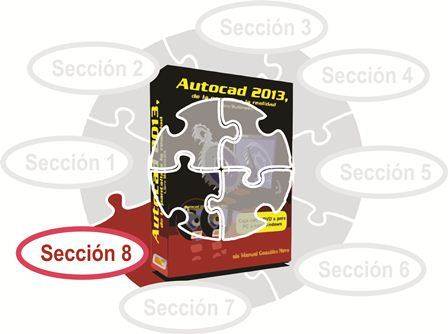3D Drawing with AutoCAD - Section 8

CHAPTER 39: MESH
Meshes are 3D objects with no physical properties such as solids. They are distinguished from surfaces because they are formed by a set of faces that converge with each other through vertices and edges. In turn, each face is formed by a facet resolution that determines its smoothing. The faces of the meshes, individually or as a whole, can increase or decrease the number of facets they contain, thereby increasing or decreasing the smoothing. On the other hand, faces can be merged with other faces or even subdivided, that is, converting the facets that make it into faces, which multiplies their possibilities of smoothing. However, one can reach the point at which program performance, by the high number of faces (and these in turn of a certain number of facets) of the mesh objects it contains.
In fact, these properties of mesh objects (their faces, facets and smoothing) are the ones that best distinguish them, since it is common to convert solids and surfaces to objects of this type simply with the idea of softening them.
But let's first look at how to create mesh objects directly and then move on to some editing tasks.
39.1 Meshes from simple objects
39.1.1 Mesh defined by sides
We can create a mesh that is bounded by lines, arcs, polylines, or splines, as long as they define a closed area by sharing their endpoints. It is what we call “Mesh defined by sides”.
The resolution of the mesh is defined by the value of two Autocad variables: Surftab1 and Surftab2, whose default value is 6. If you write these variables in the command window, you can increase or decrease their value, which will be reflected in the number of faces of new meshes (not in those already elaborated). Obviously, with a high value of these variables, the precision and "smoothness" of the surface are greater, but if they become very complex they can affect the regeneration times of objects on the screen depending on the speed and memory of your computer.
However, regardless of the value we give to these variables, we will see later on how to increase the softness of these types of objects.
39.1.2 Rules
The rule mesh is similar to the previous one, but only requires two objects that serve as sides. As only the edges of M are drawn and their resolution is given by the value of Surftab1, the value of the other variable does not affect the result.
Objects that define the surface can be lines, circles, arcs, ellipses, polylines, and splines with the condition that pairs of closed objects or pairs of open objects are used, not combined.
When using open objects, it is important to keep in mind the point where the object is pointed, since the command locates the closest end point to start from there the surface. That is to say, if you point opposite points, the surface will make a turn.
39.1.3 Tabulated
Tabulated meshes are generated from a profile and from a line that serves as a direction and dimension vector. In other words, we can create the profile of any object with lines, arcs, polylines or splines and then generate an extrusion of that profile. The size and direction of the extrusion is given by another straight line serving as a vector. As we have reviewed on several occasions the extrusions, there is not much to add to this, except what is necessary to exemplify this case in the following video.
39.1.4 Revolutionized
Revolutionary meshes are generated by rotating a profile on an axis, thus creating the faces of the mesh. The profile is called the path curve, the axis, the axis of revolution, which must be a line or the first line section of a polyline. By default, the profile rotates the 360 degrees, generating a closed 3D object, but we can indicate a start angle and a final angle, which do not necessarily have to be 0 and 360 degrees.
As you will recall, the above definition applies almost identically to solids and surfaces of revolution, so, again, it is only exemplified by a profile.

